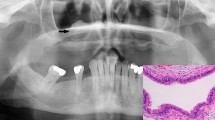Summary
Studies were carried out to identify and characterize the receptors for epidermal growth factor (EGF) in osteoblast-rich newborn rat calvarial cells and in 4 clonal lines derived from a transplantable rat osteogenic sarcoma with a well-characterized osteoblast-like phenotype. The cells were grown in monolayer culture in replicate wells; 40,000–50,000 cpm125I-labeled mouse EGF with a specific activity of 100–120µCi/µg was added to each well. Binding studies were carried out at 37°C. Binding of125I-labeled EGF was specific, saturable, reversible, and pH dependent. Maximum binding occurred 2 h after addition of the tracer. Thereafter, cell-bound radioactivity decreased to reach a plateau of 15–20% of maximum binding at 24 h. This observation is consistent with internalization and processing of the receptor-hormone complex as has been shown with other EGF target cells. Scatchard analyses revealed a single class of high-affinity binding sites in the normal and malignant osteoblast-like cells. Dissociation constants (KD) in the clonal lines ranged from 2.3 × 10−10M to 4.7 × 10−10M with receptor number per cell ranging from 25,000 to 33,000. The calvarial cells had a KD of 2.0 × 10−10M with 14,000 receptors per cell. In both the normal and malignant cell strains, EGF was found to increase incorporation of3H-labeled thymidine into acid-precipitable macromolecules. EGF has been shown to stimulate bone resorption; however, studies in organ cultures have not identified the target cell for EGF. The present results point to an interaction of EGF with osteoblasts.
Similar content being viewed by others
References
Carpenter G, Cohen S (1979) Epidermal growth factor. Ann Rev Biochem 48:193–216
Starkey RH, Cohen S, Orth DN (1975) Epidermal growth factor: identification of a new hormone in human urine. Science 189:800–802
Carpenter G, Cohen S (1976)125I-labelled human epidermal growth factor. Binding, internalization and degradation in human fibroblasts. J Cell Biol 71:159–171
Schlessinger J, Schechter Y, Willingham MC, Pastan I (1978) Direct visualization of binding, aggregation and internalization of insulin and epidermal growth factor on living fibroblastic cells. Proc Natl Acad Sci USA 75:2659–2663
Gorden P, Carpentier J, Cohen S, Orci L (1978) Epidermal growth factor: morphological demonstration of binding, internalization and lysosomal association in human fibroblasts. Proc Natl Acad Sci USA 75:5025–5029
Tashjian AH Jr, Levine L (1978) Epidermal growth factor stimulates prostaglandin production and bone resorption in cultured mouse calvaria. Biochem Biophys Res Commun 85:966–975
Voelkel DF, Tashjian AH Jr, Levine L (1980) Cyclo-oxygenase products of arachidonic acid metabolism by mouse bone in organ culture. Biochim Biophys Acta 620:418–428
Shupnik MA, Ip NY, Tashjian AH Jr (1980) Characterization and regulation of receptors for epidermal growth factor in mouse calvaria. Endocrinology 107:1738–1746
Raisz LG, Simmons HA, Sandberg AL, Canalis E (1980) Direct stimulation of bone resorption by epidermal growth factor. Endocrinology 107:270–273
Canalis E, Raisz LG (1979) Effect of epidermal growth factor on bone formation in vitro. Endocrinology 104:862–869
Partridge NC, Frampton RJ, Eisman JA, Michelangeli VP, Elms E, Bradley TR, Martin TJ (1980) Receptors for 1,25(OH)2 vitamin D3 enriched in cloned osteoblast-like rat osteogenic sarcoma cells. FEBS Lett 115:139–141
Martin TJ, Ingleton PM, Underwood JCE, Michelangeli VP, Hunt NH, Melick RA (1976) Parathyroid hormone-responsive adenylate cyclase in induced transplantable osteogenic rat sarcoma. Nature 260:436–438
Ingleton PM, Underwood JCE, Hunt NH, Atkins D, Giles B, Coulton LA, Martin TJ (1977) Radiation induced osteogenic sarcoma in the rat as a model of hormone responsive differentiated cancer. Lab Anim Sci 27:748–756
Martin TJ, Ingleton PM, Coulton LA, Melick RA (1979) Metabolic properties of hormonally responsive osteogenic sarcoma cells. Clin Orthop 140:247–254
Underwood JCE, Melick RA, Dangerfield VM, Crawford A, Coulton LA, Ingleton PM, Martin TJ (1979) Structural and functional correlations in parathyroid hormone responsive transplantable osteogenic sarcomas. Eur J Cancer 15:1151–1158
Ingleton PM, Coulton LA, Preston CJ, Martin TJ (1979) Alkaline phosphatase in serum and tumours of rats bearing a hormone-responsive transplantable osteogenic sarcoma. Eur J Cancer 15:685–691
Partridge NC, Alcorn D, Michelangeli VP, Kemp BE, Ryan GB, Martin TJ (1981) Functional properties of hormonally responsive cultured normal and malignant rat osteoblastic cells. Endocrinology 108:213–219
Savage R, Cohen S (1972) EGF and a new derivative. Rapid isolation procedures and biological and chemical characterization. J Biol Chem 247:7609–7611
Hunter WM, Greenwood FC (1962) Preparation of iodine 131-labelled growth hormone of high specific activity. Nature 194:495–496
Osborne CK, Monaco ME, Lippman ME, Kahn CR (1978) Correlation among insulin binding, degradation, and biological activity in human breast cancer cells in long-term tissue culture. Cancer Res 38:94–102
Kissane JM, Robbins E (1958) Fluorometric measurement of deoxyribonucleic acid in animal tissues with special reference to the central nervous system. J Biol Chem 233:184–188
Carpenter G, Lembach KJ, Morrison MM, Cohen S (1975) Characterization of the binding of125I-labelled epidermal growth factor to human fibroblasts. J Biol Chem 250:4297–4303
Aharonov A, Pruss RM, Herschman HR (1978) Epidermal growth factor. Relationship between receptor regulation and mitogenesis in 3T3 cells. J Biol Chem 253:3970–3977
Hollenberg MD, Cuatrecasas P (1975) Insulin and epidermal growth factor. Human fibroblast receptors related to deoxyribonucleic acid synthesis and amino acid uptake. J Biol Chem 250:3845–3853
Wrann MM, Fox CF (1979) Identification of epidermal growth factor receptors in a hyperproducing human epidermoid carcinoma cell line. J Biol Chem 254:8083–8086
Shupnik MA, Tashjian AH Jr (1982) Functional receptors for epidermal growth factor on human osteosarcoma cells. J Cell Physiol (in press)
Martin TJ, Partridge NC (1981) Initial events in the activation of bone cells by parathyroid hormone, prostaglandins and calcitonin. In Cohn D, Talmage RV (eds): Hormonal Control of Calcium Metabolism, Excerpta Medica Int. Congr. Ser 511, Amsterdam, pp 147–156
Author information
Authors and Affiliations
Rights and permissions
About this article
Cite this article
Ng, K.W., Partridge, N.C., Niall, M. et al. Epidermal growth factor receptors in clonal lines of a rat osteogenic sarcoma and in osteoblast-rich rat bone cells. Calcif Tissue Int 35, 298–303 (1983). https://doi.org/10.1007/BF02405050
Issue Date:
DOI: https://doi.org/10.1007/BF02405050




